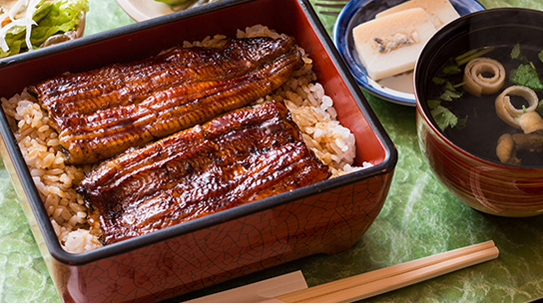
If you’ve ever wandered through the culinary wonders of Japan, you may have come across a dish that seems mysterious at first glance, but utterly unforgettable after the first bite: unagi, or freshwater eel. And when it comes to unagi, Hamamatsu, a coastal city in Shizuoka Prefecture, is one of the most celebrated places in the country.
A Bite into History and Tradition
Hamamatsu’s connection to unagi stretches back over a century. Thanks to its access to the brackish waters of Lake Hamana (Hamana-ko), the city became a natural center for eel farming. The combination of clean water, ideal climate, and generations of culinary expertise has turned Hamamatsu into a true unagi mecca.
Here, unagi isn’t just food — it’s culture. From long-standing traditional restaurants with secret family recipes to bustling street markets filled with the aroma of grilled eel, Hamamatsu offers an unforgettable sensory experience.
What Makes Hamamatsu Unagi So Special?
The answer lies in the perfect harmony of technique and ingredients. The eel is typically grilled over charcoal (kabayaki style), after being steamed to achieve an incredibly tender texture. It’s then coated with a sweet-savory soy-based glaze that caramelizes as it cooks, creating a rich, smoky flavor.
Served over a bed of fluffy white rice in a lacquered box (unajū) or bowl (unadon), this dish is beloved for its balance — not too fishy, not too sweet — and its deeply satisfying umami.
More Than Just a Meal
In Japanese culture, unagi is often eaten in the summer, especially on a day called Doyo no Ushi no Hi, as it’s believed to boost energy and fight fatigue. For visitors, enjoying unagi in Hamamatsu is not just about the taste — it’s about experiencing a local tradition that nourishes both body and spirit.
A Must-Try for the Adventurous Foodie
While some first-timers may hesitate due to its unique appearance, those who take the plunge often find unagi to be one of the highlights of their culinary journey in Japan. Especially when it’s from Hamamatsu — where every bite tells a story of dedication, history, and the art of Japanese cuisine.
So next time you’re in Japan and want to try something authentically local, don’t miss Hamamatsu’s unagi. It might just become your new favorite comfort food.
浜松の鰻(うなぎ)の美味なる伝統
もしあなたが日本の料理の不思議を探し歩いたことがあるなら、最初は少し謎めいて見えるけれど、一口食べれば完全に忘れられなくなる料理に出会ったことがあるかもしれません。それがunagi、つまり淡水ウナギです。そして鰻と言えば、浜松――静岡県の海辺の都市――は、日本でもっとも称賛される場所のひとつです。
歴史と伝統へのひと口
浜松の鰻との関係は、100年以上も前にさかのぼります。浜名湖(浜名湖)の汽水域へのアクセスのおかげで、この街は自然とウナギ養殖の中心地となりました。清らかな水、理想的な気候、そして何世代にもわたる料理の技術が組み合わさり、浜松はまさに本物のうなぎの聖地となったのです。
ここでは、うなぎはただの食べ物ではなく、文化そのものです。家族に代々伝わる秘伝のレシピを守る老舗の伝統的な料理店から、うなぎの香ばしい匂いで満ちたにぎやかな市場まで、浜松は忘れられない五感の体験を提供してくれます。
なぜ浜松の鰻はそんなに特別なのか?
その答えは、技法と素材の完璧な調和にあります。ウナギは通常、蒸された後に炭火で焼かれる(蒲焼きスタイル)ため、非常に柔らかい食感を持っています。その後、甘辛い醤油ベースのタレが塗られ、それが焼かれることでキャラメルのように香ばしくなり、豊かでスモーキーな味わいになります。
漆塗りの箱(重箱)や丼にふっくらした白ご飯と一緒に盛られ、この料理は「魚っぽすぎず」「甘すぎず」――まさに完璧なバランスで、深い旨味で愛されています。
ただの食事を超えた存在
日本文化において、うなぎは夏によく食べられます。特に「土用の丑の日」には、精力をつけ、疲労を吹き飛ばすと信じられています。旅行者にとって、浜松でうなぎを楽しむことは、味わうだけでなく、地元の伝統を体験し、心と体の両方を養うことでもあるのです。
冒険好きなグルメにとってのマスト・トライ
初めて見る人の中には、その見た目にためらう人もいるかもしれませんが、一歩踏み出した人の多くは、うなぎが日本旅行での食のハイライトだったと感じます。特に浜松のうなぎであれば――そこには、献身、歴史、そして和食の芸術の物語が一口ごとに込められています。
ですから、次に日本に来て、何か本当に“地元らしいもの”を食べたいと思ったら、浜松のうなぎをお見逃しなく。それはきっと、あなたの新しいお気に入りの“コンフォートフード(心を満たす料理)”になるかもしれません。
